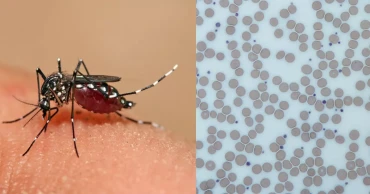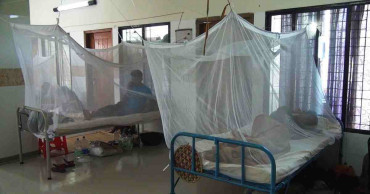dengue fever
Naogaon residents battle dengue surge as urban services falter
In Naogaon municipality, the relentless rise of dengue cases is exposing a deeper public health crisis, as residents confront swarms of mosquitoes amid longstanding urban sanitation failures.
For weeks, communities across the town have battled insects invading homes, schools, businesses and offices—pestering residents even in daylight hours. Coils, sprays and smoke have become everyday essentials, yet the relentless buzzing and painful bites continue.
Locals said what was once a seasonal nuisance has transformed into a source of fear, frustration and growing anger at local authorities.
Read more: Young adults hit hard as Bangladesh logs 593 dengue cases, 3 deaths
A Town on Edge
Naogaon Municipality, home to over 268,000 people across nine wards, is facing what locals describe as a preventable mosquito explosion. Open heaps of uncollected garbage, uncovered and clogged drains, and stagnant water turning neighbourhoods into breeding grounds have compounded the crisis.
“We close our doors and windows before evening, but it’s useless. Mosquitoes fly over burning coils. Their bites cause swelling and a burning sensation. I spend at least Tk 10 a day on coils, but if this continues, dengue is unavoidable,” said Shamim Ahmed, a resident of Masterpara.
Students are among the hardest hit. “Studying has become nearly impossible. I have to sit inside a mosquito net with a coil burning. This is no way to study,” said Arif Hossain from the Degree Mor area.
Tax Increasing, Services Declining
Residents complain that despite yearly hikes in municipal taxes, improvements in mosquito-control efforts are barely visible. Many allege that fogging and spraying target administrative or high-profile areas, leaving densely populated neighbourhoods neglected.
“There’s a municipal waste dump near my house. Mosquito-control activities here are rare. We pay higher taxes every year, but receive no proper services,” said Asfaq Uddin of Komaigari.
Read more: Best Foods to Increase Platelets in Dengue Fever
Health Risks Growing
According to the Naogaon Civil Surgeon’s Office, 56 new dengue cases were reported as of November 23. October saw 120 cases and September 116, bringing the district’s total infections this year to 321.
At Naogaon 250-bed General Hospital, 120 dengue patients were treated over the last three months. “No deaths have occurred so far, and we are providing adequate treatment,” said hospital statistician Dilruba Sultana.
Nationwide, the situation remains concerning. The DGHS reported two more dengue deaths on Monday, pushing the national toll to 366. With 705 new cases on the same day, the total infections reached 90,969 this year.
Local Authorities Admit Limitations
Naogaon Municipality Engineer Sajjad Hossain acknowledged the challenges, noting that the municipality has only three fogging machines and three hand-spray units.
“For the past two years, we haven’t received dedicated funds for mosquito control. We are running operations using municipal revenue and prioritising hand spraying, as it destroys larvae more effectively,” he said.
Read more: 8 more dead, 778 hospitalised as Bangladesh fails to curb dengue
1 month ago
10 Dengue Myths Debunked: Here are the Facts
Dengue, often referred to as break-bone fever, poses a considerable risk. The world has witnessed its spread as an epidemic, affecting millions globally. Amid this global health concern, some myths surrounding dengue are leading to misinformation and misguided treatment approaches. This article is going to debunk 10 myths about dengue. Let’s clear up these misconceptions about this formidable mosquito-borne disease for effective prevention.
10 Misconceptions about Dengue
Dengue is Contagious
Dengue primarily spreads through the bite of infected Aedes mosquitoes. It is not a contagious disease. It is not transmitted through person to person contacts.
While dengue is not typically transmitted from person to person, there are exceptional circumstances to consider. For instance, an infected pregnant mother can pass the virus to her developing fetus. Additionally, transmission via blood products, organ donation, and transfusions, while extremely rare, is not entirely impossible.
Read more: Exploring Dengue Diagnosis: The Essential Tests for Detecting the Virus
Dengue Prevails in Rural or Developing Areas
This myth does not hold when examining the global reach of this infectious disease.
Dengue is not limited to any specific geographical or economic boundaries. Dengue can occur in any country where the Aedes mosquito species are present. This includes tropical and sub-tropical climates worldwide, encompassing both urban and semi-urban areas.
Children and Elderly Are Susceptible to Dengue
It's crucial to clarify that dengue can affect individuals of all ages, regardless of their age, gender, or socioeconomic status.
Dengue virus does not discriminate based on age. People of all age groups are susceptible to dengue infection, and this includes infants, children, teenagers, and adults. It's true that certain risk categories, such as children and the elderly, are more vulnerable due to their potentially weakened immune systems. However, even healthy individuals can contract dengue or develop severe symptoms.
Read more: Dengue Fever: Symptoms, diagnosis, treatment, prevention
Any Mosquito Can Carry Dengue Virus
In reality, dengue can only be transmitted through the bite of a female mosquito belonging to the Aedes Aegypti or the Aedes Albopictus species. This certain species is distinguished by its characteristic white markings on the legs. The transmission occurs when it bites an infected individual and subsequently bites a healthy and non-infected person. After an incubation period of about a week, the same mosquito can transmit the disease to another individual. It makes these particular mosquito species the primary vectors for dengue transmission.
Dengue Mosquitoes Only Bite During the Day
While it is true that dengue-spreading mosquitoes are more active during the daytime, their feeding habits can extend into nighttime hours. These mosquitoes are typically most active around two hours after sunrise and a few hours before sunset. However, they have been observed biting people at night, particularly in well-lit areas.
One of the risk factors for nighttime exposure to dengue mosquitoes is the presence of artificial lighting. These mosquitoes can be drawn to indoor environments, including offices, malls, indoor auditoriums, and stadiums that use artificial lights throughout the day and night.
Read more: How to Protect Babies and Children from Dengue Fever
2 years ago
How to Protect Babies and Children from Dengue Fever
Dengue fever is a prevalent mosquito-borne viral disease that affects people of all ages, including babies and children. It is caused by the dengue virus, which is primarily transmitted through the bite of infected Aedes mosquitoes. In Bangladesh, dengue fever poses a significant health risk, particularly during the monsoon season when mosquito population increases. So during this time taking proper measurements to safeguard people especially babies and children from dengue fever is very important.
Dengue Symptoms in Babies and Children
Recognising the symptoms of dengue fever in babies and children is crucial for timely intervention. While some individuals may experience mild symptoms or remain asymptomatic, others may develop severe manifestations. Common signs of dengue fever in babies and children are included below.
- High fever often reaching 104°F (40°C) or higher for 2 to 7 days- Rash usually after the fever subsides- HeadacheBody aches includeing joint and muscle pain - Nausea, vomiting, and loss of appetite- Fatigue and weakness- Bleeding from the nose, gums, or small bruises in severe casesEye Pain
Read more: Read more: Dengue Fever: Symptoms, diagnosis, treatment, prevention
It's important to note that symptoms can vary from mild to severe, and some children may not exhibit all of these symptoms. If you suspect your child has dengue fever, it's essential to consult a healthcare professional for proper diagnosis and treatment.
10 Prevention Measures to Save Babies and Children from Dengue
Protecting babies and children from dengue fever requires a comprehensive approach that focuses on prevention. Here are ten essential tips to safeguard babies and children from dengue fever.
Eliminate Mosquito Breeding Sites
Mosquitoes that transmit the dengue virus breed in standing water. Try to regularly inspect your surroundings and eliminate any sources of stagnant water. It would be wise to empty and clean water containers such as flower pots, buckets, and pet bowls, ensuring that water storage tanks are tightly covered. Also discard any items that can collect water, such as old tyres or unused containers. Overall try to keep your surroundings clean and tidy.
Read more: Dengue Prevention: 10 Home Remedies to Repel Mosquitoes
Use Mosquito Nets and Screens
When your child is sleeping, you can ensure a mosquito-free sleep environment by installing fine mesh mosquito nets over beds and windows. Make sure the nets are properly tucked in and free from holes. This creates a physical barrier that effectively prevents mosquito bites.
Wear Protective Clothing
It is suggested to dress your child in clothing that covers their arms, legs, and feet. Lightweight, loose-fitting, long-sleeved shirts and long pants are recommended. Tucking the pants into socks and choosing closed-toe shoes can further reduce exposed skin. Light-colored clothing is preferable as mosquitoes are attracted to darker colors.
Add Immunity Boosting Foods to Diet
Having a strong immune system provides better defense against diseases, including dengue fever. Enhancing immunity can be achieved by incorporating certain foods into your children's diet. These include yogurt, turmeric, ginger, garlic, spinach, citrus fruits, and almonds, all of which contribute to strengthening the immune system.
Read more: Best Foods to Increase Platelets in Dengue Fever
2 years ago
Best Foods to Increase Platelets in Dengue Fever
Dengue fever, an illness transmitted by mosquitoes, is a viral infection that impacts a vast number of individuals every year across the globe. It is characterized by symptoms such as high fever, severe headache, joint and muscle pain, rash, and in some cases, a decrease in platelet count. Platelets, being vital components of the blood, play a crucial role in the process of coagulation, ensuring the prevention of excessive hemorrhaging. Dengue can lead to a decrease in platelet count. While medical intervention is crucial in severe cases, certain foods can support platelet production and aid in recovery.
Platelet Counts in Dengue
In dengue fever, the virus affects the production and function of platelets, which can lead to a condition known as thrombocytopenia. In a healthy body, the standard quantity of platelets in circulation within a microliter of blood falls within the range of 150,000 to 450,000 platelets. However, during dengue fever, the platelet count can drop significantly, putting individuals at risk of bleeding.
Platelet counts below 150,000 are considered low. And when the platelet count falls below 100,000 platelets per microliter of blood, it is considered a risk zone, and immediate medical attention is required. It is essential to monitor platelet levels regularly during dengue fever to ensure appropriate medical intervention if necessary.
Read more: Dengue Prevention: 10 Home Remedies to Repel Mosquitoes
Best Foods to Increase Platelets in Dengue Fever
Eating a well-balanced and nutritious diet is vital for supporting the immune system and aiding in the recovery from dengue fever. Here are some of the best foods that can help increase platelet counts during dengue fever.
Papaya
Papaya is rich in vitamin C, which plays a crucial role in boosting platelet production. It also contains enzymes like papain that help improve digestion. Consuming ripe papaya or drinking fresh papaya juice can be beneficial. In Bangladesh, papaya is readily available and can be included in the diet easily. Try to have 1-2 servings of papaya daily.
Pomegranate
Pomegranate is a powerhouse of antioxidants and essential nutrients. It can help stimulate the production of platelets and improve overall blood circulation. Including fresh pomegranate juice or adding pomegranate seeds to salads or yogurt can be a healthy choice. Attempt for 1-2 servings of pomegranate daily.
Read more: Exploring Dengue Diagnosis: The Essential Tests for Detecting the Virus
Leafy green vegetables
Leafy green vegetables such as spinach, broccoli, and fenugreek leaves are excellent sources of vitamins, minerals, and antioxidants. They help in increasing platelet counts and boosting overall immunity. These vegetables are commonly found in Bangladesh and can be incorporated into meals or consumed as salads. It would be better to have 2-3 servings of vegetables per day.
Beetroot
Beetroot is rich in iron and folic acid, which are essential for maintaining healthy blood and increasing platelet production. It also contains antioxidants that help in detoxification. Including beetroot in salads or consuming freshly extracted beetroot juice can be beneficial. You may consume 1-2 servings of beetroot daily.
2 years ago
Dengue Fever: Symptoms, diagnosis, treatment, prevention
The Aedes mosquito causes dengue fever. If you are bitten by a mosquito that carries the dengue virus, you will get dengue fever. The infection should not be neglected. If Dengue fever progresses to a severe stage, it can threaten life. This article will discuss the symptoms, treatments, home remedies, and preventions for dengue fever.
What is Dengue?
Dengue is a viral infection that is transmitted by the Aedes mosquito. The disease is found in tropical and subtropical regions of the world, and it is estimated that there are over 400 million cases of Dengue each year. The virus that causes Dengue is called DENV, and there are four DENV serotypes. It is possible to be infected four times with the virus.
However, there is no specific treatment for Dengue, but it can be prevented by protecting against mosquito bites. The Aedes mosquito typically lays its eggs in standing water, so removing sources of standing water can help to reduce the risk of dengue transmission.
Read Conjunctivitis: Causes, Symptoms, Treatment and Prevention
Signs of Dengue Fever
There are some symptoms to look for to know whether it is dengue fever or not. Such as feeling cold, loss of appetite, body aches, headache, pain in the eyes, lower back pain, muscle pain, joint pain, rash, fatigue, swollen lymph nodes, and skin-eye redness.
In the first few hours of dengue infection, pain is felt in the legs and joints. Fever can rise very quickly to 104 degrees Fahrenheit. Heart rate and blood pressure are low during this time. A red or pink rash may appear on the face, which then disappears.
High fever and other dengue symptoms last for 2-4 days, and then the body temperature drops rapidly with sweating. Body temperature remains normal for about a day before the second rapid rise in fever, and feels healthy. Later, an itchy rash appears all over the body except the face. The palms of the hands and soles of the feet may be bright red and swollen.
Read How to entertain an unwell child without screen time
Severe Symptoms of Dengue
Sometimes dengue infection is very serious or fatal. It is called severe Dengue. Symptoms of severe Dengue appear 3-7 days after the initial symptoms of Dengue. People who have been infected with Dengue before are at higher risk of severe Dengue.
The main symptoms of severe Dengue are severe abdominal pain, abdominal swelling, vomiting blood, bleeding from the gums, bleeding under the skin, difficulty or rapid breathing, feeling cold or sweating, rapid pulse, and drowsiness/loss of consciousness. If you see the symptoms of severe Dengue, you should go to the emergency department of the hospital without a moment's delay.
How to Diagnose Dengue Fever
If you see any dengue symptoms or have a serious fever, you should consult a registered doctor for further investigations. Not every fever is Dengue. Self-diagnosed for Dengue leaves other common causes of fever, such as pneumonia, urinary tract infection, typhoid, flu, etc., undiagnosed.
Read Best foods for expecting mothers
Patient's signs, symptoms, and physical examination data can help to diagnose the disease. However, results may vary from the first day to the next 10 days of dengue fever in different tests. So, self-testing can be confusing. Therefore, it would be wise to let the doctor understand first.
Doctors initially diagnose Dengue through NS1, CBC, IgG, and IgM. A maximum of Tk. 500 can be charged for the dengue NS1 Antigen test. A maximum of Tk. 400 can be taken for CBC (RBC + WBC + Hematocrit) test. Apart from this, IgG and IgM tests should be done within 500 Takas.
Treatment and Home Remedies of Dengue Fever
There is no specific treatment for dengue fever, but there are ways to ease the symptoms. Pain relievers, rest, and fluids can help to reduce fever and pain. In severe cases, hospitalization may be necessary in order to receive intravenous fluids and close monitoring.
Read Why do Mosquitoes bite me so much?
At the initial stage, take rest and drink plenty of water or liquid food. If the body is hydrated, headaches and muscle pain will be reduced. Drink coconut water, lemon juice, fruit juice, and saline at home.
Paracetamol can be taken to reduce the fever. However, a doctor's consultancy is needed if the patient has heart, liver, and kidney-related complications.
Aspirin, Clofenac, and Ibuprofen-like medicines should not be taken for body pain when suffering from dengue fever. Taking such medicines during Dengue can cause bleeding.
Read How to Apply for Indian Medical Visa from Bangladesh
What not to do
Platelets are no longer a key factor in dengue fever. There is no need to worry about the platelet count. If the platelet count falls below 10,000 or if there is bleeding from any part of the body, platelets or fresh blood can be given if necessary. However, such situations are very rare.
Many people say that eating papaya leaf juice etc. increases platelets. Actually, these have no role. After the fever subsides, platelets begin to grow by themselves after the crisis period has passed. At the end of the fever, the blood pressure may drop, or there may be bleeding from the gums, nose, or rectum. If this is the case, intravenous saline may be needed. In these cases, hospital admission is required.
When to go to the hospital
In the case of Dengue, what kind of treatment to take, staying at home or in a hospital, depends on its type or category. There are three types or categories of dengue fever - 'A,' 'B,' and 'C.' Patients in the first category are normal. They only have a fever. Most dengue patients are in the 'A' category. They do not require hospitalization. Resting at home is enough.
Read Top 10 Bathroom Plants to grow in humid environment of shower
Category 'B' dengue patients may require hospitalization. Certain symptoms, such as abdominal pain, vomiting, diabetes, obesity, pregnancy, congenital problems, and kidney or liver problems, are recommended for hospitalization.
Category 'C' dengue fever is the worst. It can damage the liver, kidneys, and brain. In some cases, an intensive care unit or ICU may be required.
So, you have to follow the doctor's instructions.
Read Motorcycle Accident Prevention: Tips to Reduce the Risk of a Crash
Dengue Fever Season in Bangladesh
Generally, the dengue outbreak occurs from July to October in Bangladesh, as the Aedes mosquito spreads during this period. But we have to be careful throughout the year as in some years; Dengue started in June.
Preventive Measures for Dengue Fever
The Aedes mosquito usually lays its eggs in clear water. So, make sure water does not stay for more than three to five days. This water can accumulate anywhere. Aedes mosquitoes breed in the water collected on the roof of the house or in the flower tub of the balcony, at various points of the building under construction, tires lying on the side of the road, or in other containers.
So, check if there is any stagnant water in any places around the house. Also, use mosquito nets and spray in the house. Additionally, use mosquito repellent cream while going out or staying at home.
Read Should You See a Therapist? 8 Surefire Signs You Need Help
Final Words
In Bangladesh, the Dengue death toll is rising every year. Especially in the cities and towns, many inhabitants are being affected by Dengue fever. Some prevention measures for Dengue can minimize the spread of the disease.
However, all fevers are not Dengue. So, make sure you know the sign and symptoms of Dengue Fever to determine if you have it or not. You may also get affected by viral fever too. So far, we have discussed the diagnosis process of Dengue fever. Proper consultations with doctors are essential to avoid serious medical conditions. If proper treatment for Dengue fever is provided the patient can be cured.
3 years ago
Another Dengue patient dies; 91 hospitalised in 24 hrs
Another Dengue patient died and 91 others were hospitalised in 24 hours till Thursday morning.
With the latest death, the authorities recorded 13 deaths from the viral infection this year, according to the Directorate General of Health Services (DGHS).
The latest death was reported from Cox’s Bazar district.
Also read: Dengue: 77 new patients hospitalised in 24 hrs
Among the deaths this year, nine were reported from Cox’s Bazar while four from Dhaka.
Of the new patients, 67 patients were hospitalised in Dhaka while the 24 in other places, it said.
As many as 348 dengue patients including 263 in the capital are now receiving treatment at hospitals across the country.
Also read: Dengue death toll rises to 12 as 2 more die; 65 new patients hospitalised
On June 21, the DGHS reported the first death of the season from the viral disease.
This year, the DGHS has recorded 2,980 dengue cases and 2,619 recoveries so far.
3 years ago
Bangladesh sees rise in Dengue cases: 18 more cases confirmed
Bangladesh reported 18 new dengue cases in the 24 hours till Monday morning ahead of monsoon.
All 18 people were hospitalised with dengue' a viral infection, in Dhaka city, according to the Directorate General of Health Services (DGHS).
Fifty-one dengue patients, including 50 in the capital, are receiving treatment at hospitals.
In 2022, the DGHS has recorded 338 dengue cases and 287 recoveries so far. However, it has not yet reported any death from the mosquito-borne viral disease.
Also read: 15 more dengue cases confirmed
A total of 105 dengue patients including 95 in Dhaka division alone died in 2021.
Dengue – a leading cause of serious illness and death in some Asian and Latin American countries – was first reported in Bangladesh in 2000 and claimed 93 lives. In three years, the fatality number almost fell to zero.
There is no specific treatment for dengue or severe dengue. Early detection of disease progression associated with severe dengue, and access to proper medical care lowers fatality rates of severe dengue to below 1 percent, according to World Health Organization.
Also read: 15 dengue cases reported in 24 hours: DGHS
"The global incidence of dengue has grown dramatically, with about half of the world's population now at risk. Although an estimated 100-400 million infections occur each year, over 80 percent are generally mild and asymptomatic," it said.
3 years ago
Dengue: 53 more hospitalized in 24 hrs
Fifty-three new dengue patients have been hospitalised in 24 hours until Saturday morning, health authorities said.
The number of fatalities from the mosquito-borne disease remained unchanged at 98 in the current year as no fresh death was reported during the period, according to the Directorate General of Health Services (DGHS).
Ninety people died in Dhaka division alone, two each in Chattogram, Mymensingh and Khulna divisions and one each in Rajshahi and Barishal divisions.
Also read: December gives Dhaka dwellers a break from heat, but not from dengue
Twenty-four new patients are undergoing treatment in hospitals in Dhaka while the remaining 29 cases have been reported from outside the division.
Some 293 patients diagnosed with dengue are receiving treatment in the country as of Friday.
Of them, 213 patients are receiving treatment at different hospitals in the capital while the remaining 80 were listed outside Dhaka.
Since January, some 27,536 patients have been admitted to different hospitals with dengue in the country. So far, 27,145 dengue patients have left hospitals after recovery, said DGHS.
Also read: Dengue: 32 more hospitalized in 24 hrs
Experts attribute the unusually high dengue cases during the dry season, mainly in Dhaka, to the prolonged rainy season, sporadic rainfall, and high humidity and temperature, Aedes mosquitoes' reproductive and behavioural changes caused by climate change and lack of people’s awareness and poor controlling measures by the two city corporations of the capital.
They also said the climate conditions of Bangladesh are becoming more favourable for the Aedes mosquitos to prevail in all seasons with high or low intensity mainly for the increase in temperature and breeding sources.
4 years ago
Dengue: 87 more patients hospitalised in 24 hrs
Eighty-seven new dengue patients have been hospitalised in 24 hours until Saturday morning, health authorities said.
The number of fatalities from the mosquito-borne disease remained unchanged at 98 in the current year as no fresh death was reported during the period, according to the Directorate General of Health Services (DGHS).
Of the deceased, 90 people died in Dhaka division alone, two each in Chattogram, Mymensingh and Khulna divisions and one each in Rajshahi and Barishal divisions.
Also read: Dengue: 58 more hospitalized in 24 hrs
Among the new patients, 57 are undergoing treatment in hospitals in Dhaka while the remaining 30 cases have been reported from outside the division.
Some 428 patients diagnosed with dengue are receiving treatment in the country as of Saturday.
Of them, 320 patients are receiving treatment at different hospitals in the capital while the remaining 108 were listed outside Dhaka.
Also read: Dengue in Bangladesh: 118 more hospitalized in 24 hrs
Since January, some 27,004 patients have been admitted to different hospitals with dengue in the country. So far, 26, 478 dengue patients have left hospitals after recovery, said DGHS.
4 years ago
Dengue cases keep rising: 142 more hospitalized in 24 hrs
Bangladesh reported hospitalisation of 142 new dengue patients in 24 hours until Saturday morning.
Although dengue cases were supposed to drop ahead of winter, the country has been recording more than 100 dengue cases per day over the last few weeks.
Seventy two people were hospitalised with dengue fever on Friday.
The number of fatalities from the mosquito-borne disease remained unchanged at 98 in the current year as no fresh death was reported during the period, according to the Directorate General of Health Services (DGHS).
Also read: Dengue cases drop: 72 more hospitalized in 24 hrs
Of the deceased, 90 people died in Dhaka division alone, two each in Chattogram, Mymensingh and Khulna divisions and one each in Rajshahi and Barishal divisions.
Among the new patients, 104 are undergoing treatment in hospitals in Dhaka while the remaining 38 cases have been reported from outside the division.
Some 543 patients diagnosed with dengue are receiving treatment in the country as of Saturday.
Of them, 436 patients are receiving treatment at different hospitals in the capital while the remaining 107 were listed outside Dhaka.
Also read: Dengue: 129 more hospitalized in 24 hrs
Since January, some 26,201 patients have been admitted to different hospitals with dengue in the country. So far, 25, 586 dengue patients have left hospitals after recovery, said DGHS.
In September, the country recorded the highest number of 7,841 dengue cases of the current year with 23 deaths.
In October, the number of dengue cases came down to 5,604 with 22 deaths recorded.
4 years ago








.jpg)
.jpg)






